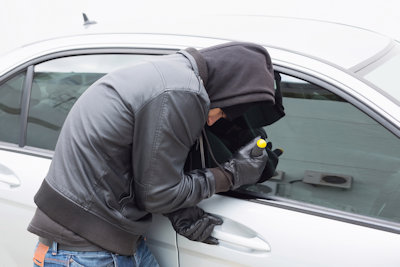Many auto thefts are crimes of “opportunity”. Leaving the keys in your car (even a “hidden” spare key) greatly increases your chances of having your car stolen.
Take your keys with you even for quick trips. Needless to say, this is especially true if you have children or pets in the vehicle.
- More than two thirds of all auto thefts occur at night.
- Approximately 86% of the stolen vehicles are recovered
- The vast majority of auto thefts are committed by criminals looking for temporary transportation. Thus, most vehicles are recovered within a few weeks to a month and with relatively little damage. Very few vehicles are stolen for parts.
- Auto theft happens fast. An expert auto thief can break into and steal a car in less than a minute. An unoccupied car, with it’s engine running, can be taken in seconds.
What attracts a car thief?
- Leaving your car unlocked or the windows down.
- Leaving your keys in the car or a spare key hidden in the car.
- Leaving your car unattended.
- Parking in poorly lit places with low visability.
- Leaving valuables and packages in your car.
- Cars not protected with an anti-theft device.
How to protect your car
- Don’t leave your keys in your car.
- Close your windows and lock your doors whenever you leave your car, regardless of how long you plan to be gone.
- Park in well-lit areas.
- Keep your car in a garage if you have one.
- Park in lots that have attendants.
- Use an anti-theft device whenever you leave your car .
- When parking your car, turn your wheels toward the curb to make it more difficult for a thief to “tow” your car.
- Use your emergency brake when you park.
- Engrave your driver’s license number preceded by the state letters (WA D.L.) or your car’s Vehicle Identification Number (VIN) on any removable equipment in your car.
- Replace “T-shaped” door locks with straight locks so thieves cannot grab them with an implement through a crack in the window.
- Immediately report any suspicious activity to the police.
When you are in your car
- Keep your doors and windows locked, no matter how short the distance or how safe you feel in the neighborhood.
- When you’re coming to a stop, leave enough space to maneuver around other cars. If you sense trouble, this will allow you the room needed to get away.
- If a suspicious-looking person approaches your car, drive away carefully.
- Drive in the inside (center) lane to make it more difficult for would-be carjackers to approach your car.
- Don’t stop to assist a stranger whose car has broken down. Instead, help by driving to the nearest phone or using your cell phone to call the police for help.


